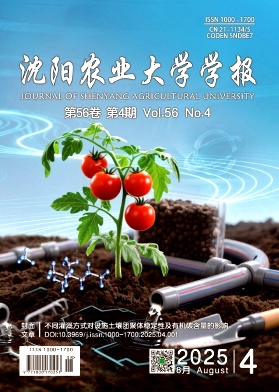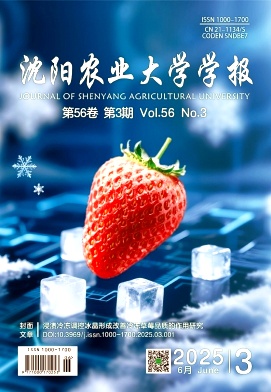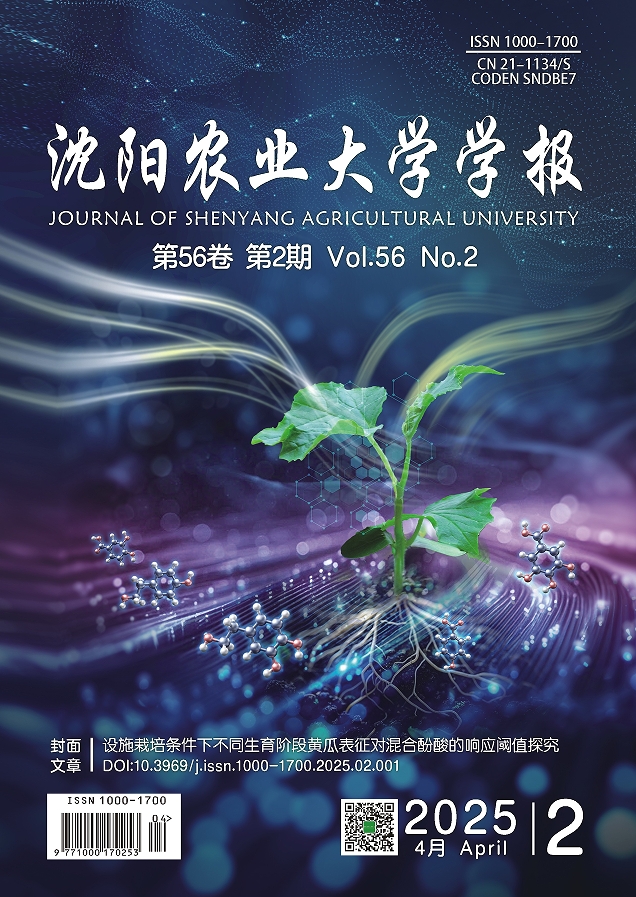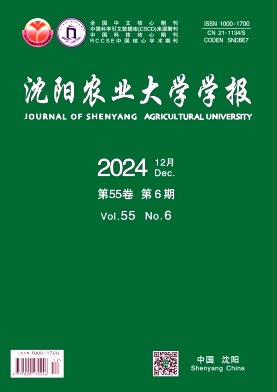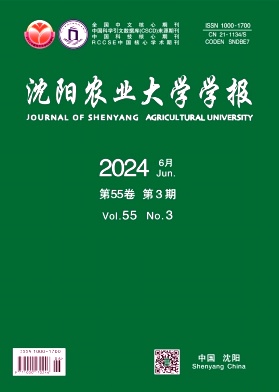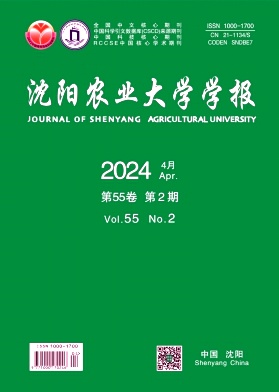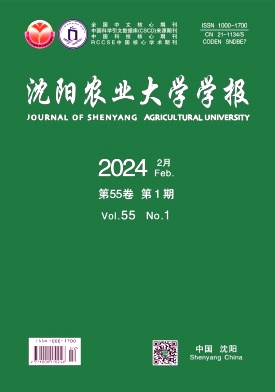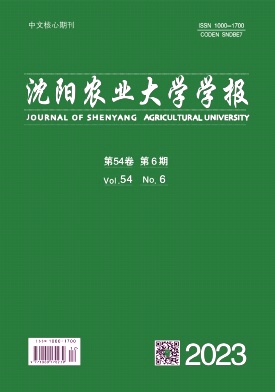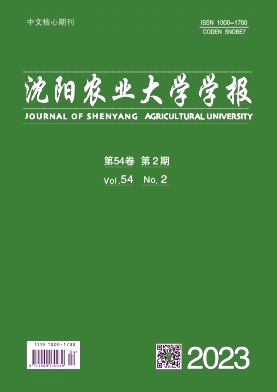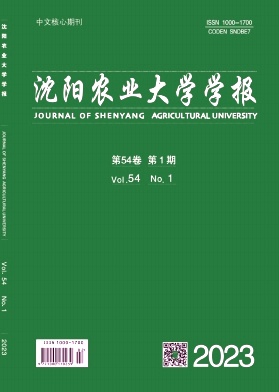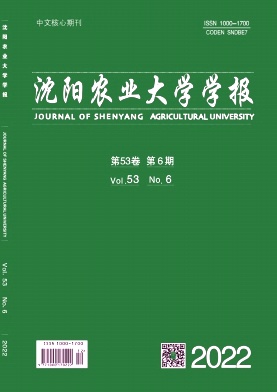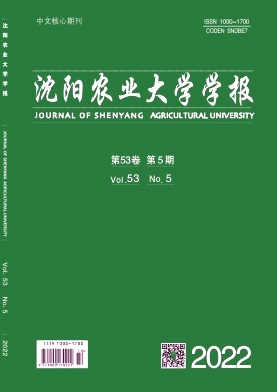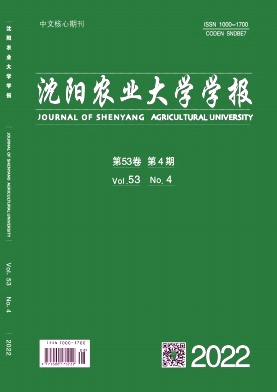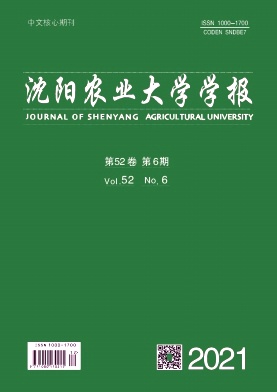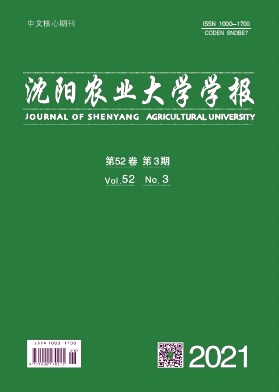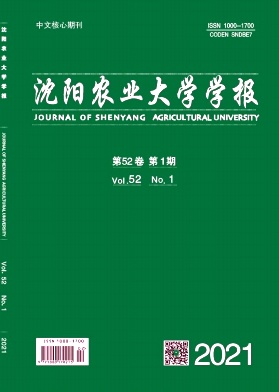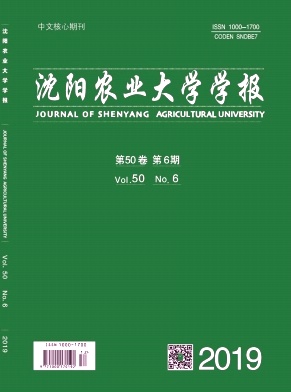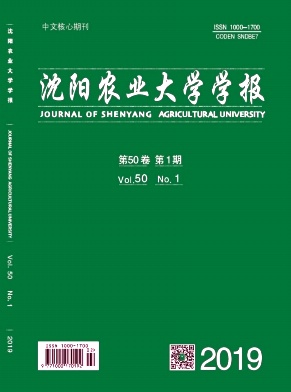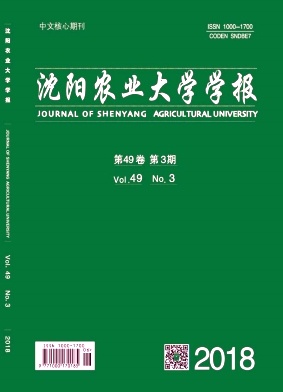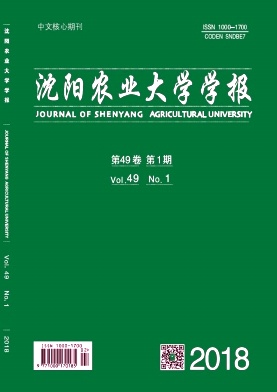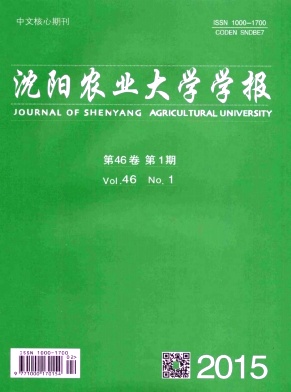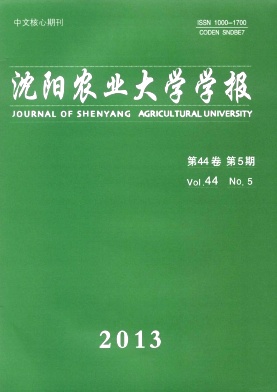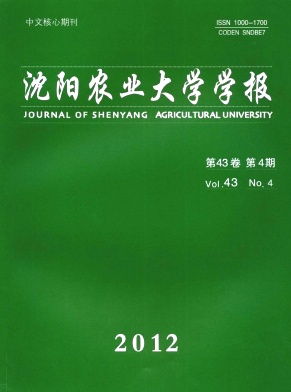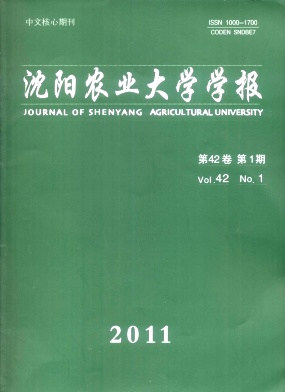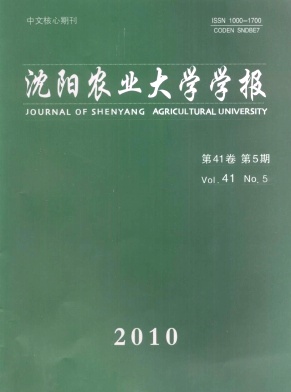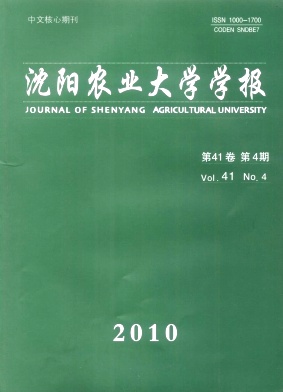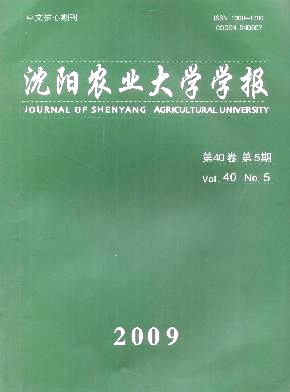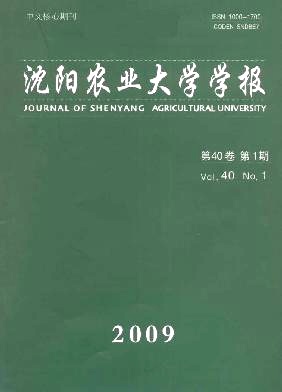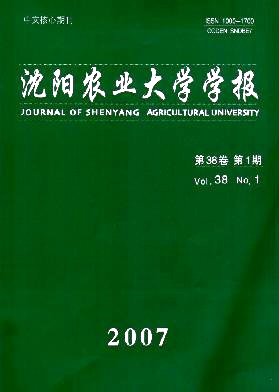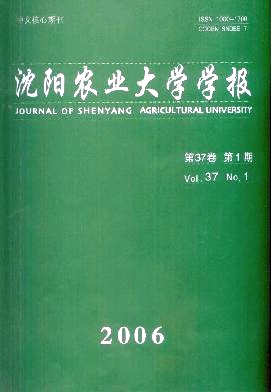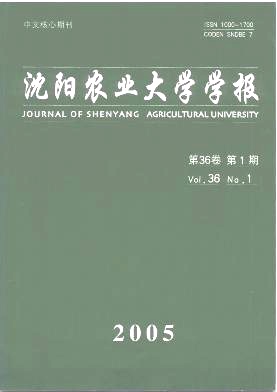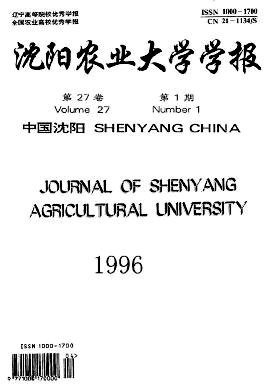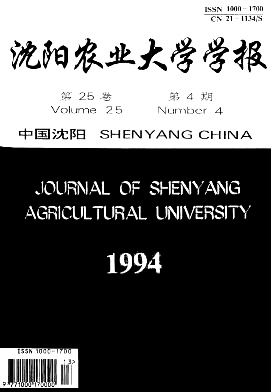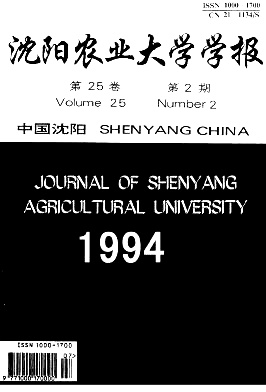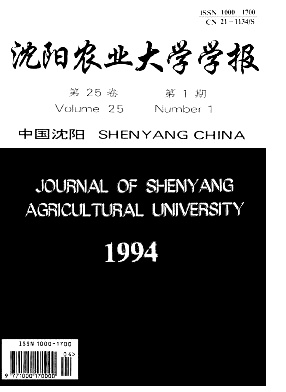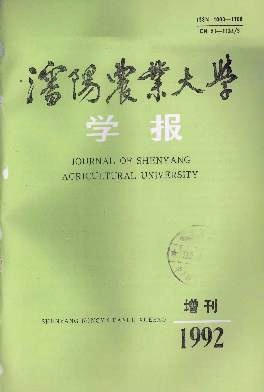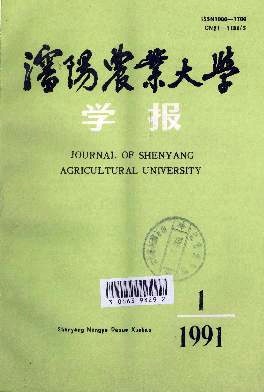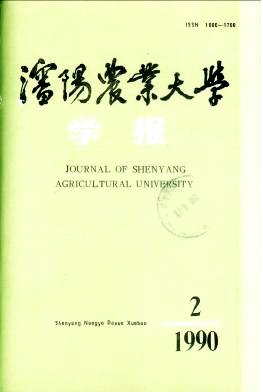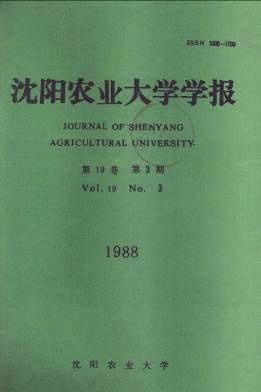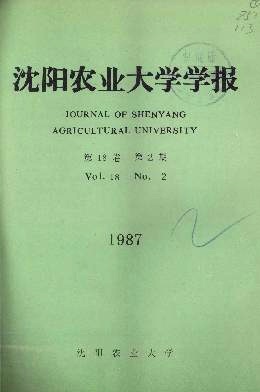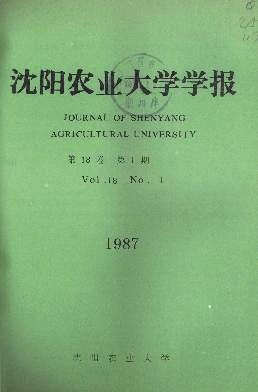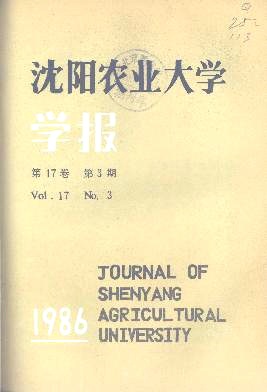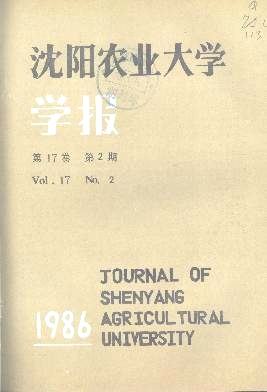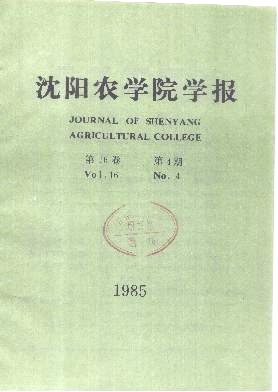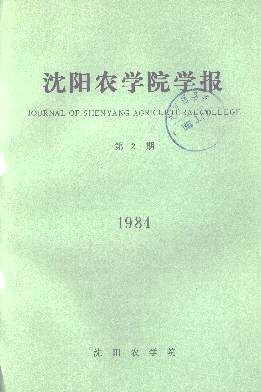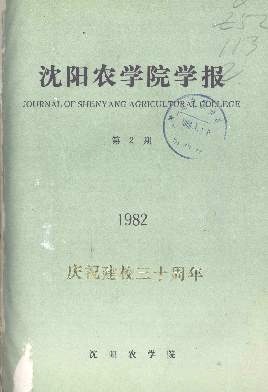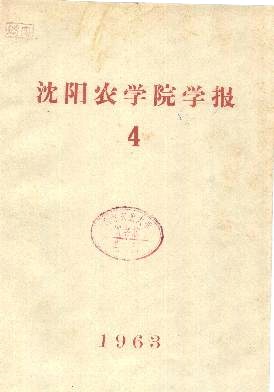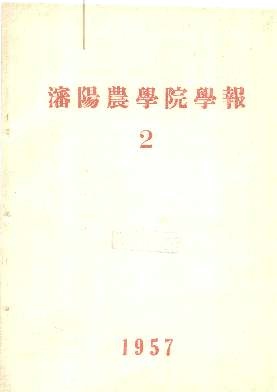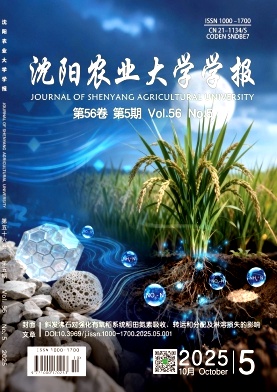
Tracking the information about your manuscript
Communicate with the editorial office
Query manuscript payment status Editors LoginCollecting, editing, reviewing and other affairs offices
Managing manuscripts
Managing author information and external review Expert Information Reviewers LoginOnline Review
Online Communication with the Editorial Department
Downloads
Page Views
Page visits today: 539

Introduction
Journal title: Journal of Shenyang Agricultural University
Established: June 1956
Governed by: The Education Department of Liaoning Province
Sponsored by: Shenyang Agricultural University
Publication Frequency:Bimonthly
Tel: 86-24-88487083
Email: syndxb@126.com
CN: 21-1134/S
ISSN: 1000-1700
Online First
Effects of Zeolite on N Uptake,Translocation,and Allocation and N Leaching in an Intensive Aerobic Rice System
CHEN Xuda;LIU Boyang;CHEN Wei;CHI Daocai;CHEN Taotao;[Objective]The shift of paddy fields subjected from continuously flooded irrigation(ICF) to alternate wetting and drying irrigation(IAWD), and further to intensive aerobic rice system(IIARS) drives significant transformation in the soil-water environment from anaerobic to alternating aerobic-anaerobic, and further to aerobic. This alternation inevitably resulted in varying nitrogen cycles in the paddy ecosystem. Zeolite possesses multiple advantages in agricultural applications, such as water holding, nitrogen conservation, and yield increasing or maintaining under ICFor IAWDpaddy fields. However, its effects on N uptake, translocation, allocation and N leaching remained elusive, especially under IIARS. [Methods]The 2-year field experiment was conducted as a split experiment designed in 2022-2023 to explore the impacts of zeolite management(no zeolite, Z0; 15 t·hm-2zeolite amendment, Z15) and irrigation regimes(ICF, IAWDand IIARS) on rice grain yield, water use efficiency(UWE), aboveground biomass(ABM), N uptake, translocation, and allocation, soil NH4~+and NO3~–and N leaching. [Results]Compared to ICF, IAWDand IIARSsignificantly decreased N leaching by 13.35%and 1.27% in 2022 and by 13.93% and 4.67% in 2023, respectively. Zeolite amendment significantly increased soil NH4~+and NO3~-and decreased N leaching. Notably, Z15significantly increased to 5.7%-19.2% soil NH4~+and 16.6%-19.5% soil NO3~-over two years,compared to Z0. Consequently, zeolite amendment resulted in significant decreases in N leaching by 12.21% and 12.41% in 2022 and2023, respectively. Concurrently, zeolite application significantly increased aboveground biomass and N uptake, allocation, and translocation, therefore enhancing rice grain yield and water use efficiency. [Conclusion]Zeolite could enhance N uptake, allocation,and translocation and aboveground biomass, by reducing N leaching and increasing soil NH4~+and NO3~-, which was beneficial to increase/maintain rice grain yield. Therefore, zeolite can serve as an efficient soil additive to effectively mitigate yield penalty under IIARS. This provides critical insights for the development of water-adapted agriculture on a regional-scale.
Genome-wide Identification and Comprehensive Analysis of LEA Gene Family in Rice
ZHAO He;JI Yaliang;LIANG Xiao;RUAN Banpu;YU Yanchun;MA Dianrong;[Objective]A large number of studies have shown that LEA proteins can help plants cope with environmental stress through various mechanisms. However, the functions of many LEA family members in rice have not been fully verified. Therefore, this study aimed to identify new LEA members involved in rice responses to abiotic stress through bioinformatics analysis of the OsLEA gene family and by combining their gene expression changes under different stresses. [Method]The OsLEA gene family was identified and analysed using a genome-wide bioinformatics approach. [Results]The results reveal that the rice genome contains 83 OsLEA family members, which are unevenly distributed across 12 chromosomes and can be classified into eight subfamilies based on structural domain features. Physicochemical property analysis shows that LEA proteins are highly hydrophilic and stable. Subcellular localization predictions indicate that most LEA proteins are localized in cellular compartments such as the cytoplasm, cell membrane,and mitochondria. Promoter cis-acting element analysis highlights that the OsLEA gene promoters are enriched with elements associated with abiotic stress response, phytohormone regulation, and growth and development. Tissue expression pattern and hormone response analyses reveal significant expression specificity across different tissues and under various phytohormone treatments.Additionally, certain OsLEA genes exhibit notable responses to abiotic stresses such as low and high temperatures, salt, and heavy metal(cadmium) treatments. These findings provide valuable insights into the role of OsLEA genes in coping with environmental stress.[Conclusion]This study integrated bioinformatics analysis with expression profiling data under multiple hormone treatments and abiotic stress conditions, preliminarily revealing the molecular regulatory mechanisms through which the OsLEA gene family participates in stress responses. Building on these findings, we successfully screened core member genes—including Os04g0589800,Os05g0362600, Os06g0324400, and Os08g0163600—which exhibited significant upregulation under high-salinity, high-temperature,and low-temperature stresses. This confirms their critical biological functions in abiotic stress responses and establishes them as highly promising molecular targets for breeding stress-resistant rice cultivars.
Effects of Different Cultivation Methods and Planting Density on Lodging Resistance and Yield of Soybean
ZHANG Na;CAI Lijun;LIU Jingqi;YANG Xu;ZHENG Wei;TANG Xiaodong;WANG Zhida;GAI Zhijia;Jiamusi Branch of Heilongjiang Academy of Agricultural Sciences;Soybean Institute of Heilongjiang Academy of Agricultural Sciences;[Objective]In order to explore the differences of lodging and yield of soybean between large ridge close planting,traditional ridge planting and different planting densities,the effects of different cultivation methods and planting densities on plant morphological indexes,mechanical properties of stems,lodging resistance and yield of soybean were studied.[Method]This experiment analyzed the relative chlorophyll content (SPAD),dry matter accumulation and grain traits,stem morphological characteristics,stem breaking resistance,lodging rate and yield of soybean upper,middle and lower parts under 65 cm conventional ridge (CK),130 cm large ridge inner row (C1),130 cm large ridge outer row (C2) and four planting densities (D1:2.5×105 plants·hm-2,D2:3.5×105 plants·hm-2,D3:4.5×105 plants·hm-2,D4:5.5×105 plants·hm-2).[Results]Under different cultivation methods,the SPAD of different parts of soybean showed:C2>CK>C1; the plant height,pod height,balance point and internode length showed:C1>C2>CK,the number of effective branches showed:CK>C2>C1,the number of main stem nodes showed that C1 and C2 were significantly higher than CK,stem diameter and dry matter accumulation of stems,leaves and pods in different parts showed:C2>CK>C1,and with the increase of planting density,plant height,bottom pod height,balance point and internode length increased gradually,stem diameter,effective branch number,main stem node number,dry matter accumulation in different parts and SPAD decreased gradually.The bending resistance and lodging rate of stem force were CK>C2>C1,and the effective pod number,grain number,grain weight and yield of different parts of soybean were C2>CK>C1,which decreased gradually with the increase of planting density.The 100-grain weight showed :C1>C2>CK,no response to density.[Conclusion]Regardless of high density or low density,the stem characteristics and lodging resistance of 130 cm large ridge were lower than those of 65 cm conventional ridge,but the lodging only occurred under the density of 5.5×105 plants·hm-2,and SPAD,dry matter accumulation,grain traits,yield components and yield were higher than those of 65 cm conventional ridge.
Influence of Methyl Jasmonate on Quality of Nanguo Pear
LI Xinyue;TIAN Xin;HAN Yinxiao;LI Shuai;SUN Mingyao;WANG Zeyu;MA Huaiyu;[Objective]The quality of fruit not only determines its commercial value but also significantly influences consumer purchasing decisions. Consequently, the exploration of effective techniques to regulate fruit quality is of great significance. Methyl jasmonate(MeJA) is a vital plant growth regulator known for its role in enhancing plant stress resistance and improving fruit quality.This study aims to investigate the effect of exogenous MeJA on the fruit quality of Nanguo pear and to explore effective methods to enhance the commercial value and market competitiveness of Nanguo pear. [Methods]The Nanguo pear at 84, 99, and 114 days after full bloom were treated with water(CK) and MeJA(0.50 mmol·L-1, MeJA 0.75 mmol·L-1, and 1.00 mmol·L-1), and then were sampled for measurements at 90, 105, and 120 days(7 days post-treatment), respectively. The relevant indicators of the external(fruit weight,fruit shape index, hardness) and internal(chlorophyll, carotenoids, anthocyanins, flavonoids, total phenols, soluble solids, soluble sugar, starch content) qualities of the fruits were assessed. [Results]The application of MeJA did not exert a significant impact on the fruit shape index, hardness, carotenoid content, total phenols, and flavonoids in the peel of the Nanguo pear. However, treatments with0.50 mmol · L-1MeJA and 0.75 mmol · L-1MeJA facilitated the accumulation of chlorophyll a, soluble solids, and starch content.Notably, at 90 days after full bloom, both 0.50 mmol·L-1MeJA and 0.75 mmol·L-1MeJA treatments enhanced anthocyanin content.Furthermore, 0.50 mmol·L-1MeJA increased chlorophyll b and total chlorophyll content. Whereas, 1.00 mmol·L-1MeJA treatment resulted in an increase in fruit weight and sugar content(soluble solids, soluble sugar, starch), and had the most pronounced effect on reducing chlorophyll levels. [Conclusion]Considering the comprehensive assessment of both external and internal quality indicators,the 1.00 mmol·L-1MeJA treatment was most effective in enhancing the quality of Nanguo pear. This treatment could serve as a viable technical approach to augment the market value and competitiveness of the fruit.
Immunopathological Modulatory Effect of α-Lactose on Immune Pathology Induced by Virulent Strains of Toxoplasma gondii
ZHANG Yiwei;LI Hongyu;JING Yuqi;SUN Lu;JIANG Ning;[Objective]Toxoplasma gondii, a protozoan parasite that can parasitize in the nucleated cells of almost all warm-blooded animals. Its infection can upregulate the expression of key exhaustion molecule, T cell immunoglobulin and mucin domain-containing protein 3(TIM-3) of host's spleen and peripheral blood T cells,thereby inhibiting the immune response. Previous studies showed thatα-lactose can specifically regulate the interaction between TIM-3 and its ligand Galectin-9(Gal-9), thereby weakening its inhibitory function and enhancing host's anti-infection ability. This study aims to evaluate the immunopathological modulatory effects of α-lactose, mediated by its competitive binding to the TIM-3 ligand Gal-9, in mice infected with different virulent strains of Toxoplasma gondii(RH and ME49). To provide a new strategy for the immunomodulatory treatment of Toxoplasma gondii infection. [Methods]Using a Toxoplasma gondii–infected mouse model, mouse survival rates, spleen indices, and histopathological changes in the lungs and spleen were analyzed after α-lactose was administered via subcutaneous injection. Additionally, flow cytometry was used to assess the proportions of peripheral blood lymphocyte subsets and the expression of T cell immunoreceptor with Ig and ITIM domains(TIGIT)—an immune checkpoint molecule —on the cell surface. [Results]Although α-lactose treatment prolonged the survival time of mice infected with Toxoplasma gondii, it did not improve the spleen index or the histopathological damage in the lungs and spleens.Furthermore, α-lactose treatment did not significantly increase TIGIT expression on different peripheral blood lymphocyte subsets(including CD8+ T cells and NK cells) in mice following Toxoplasma gondii infection. [Conclusion]α-lactose did not significantly influence the mice infection with Toxoplasma gondii, which may be related to the virulence of the parasite strain and the state of host immune exhaustion.
